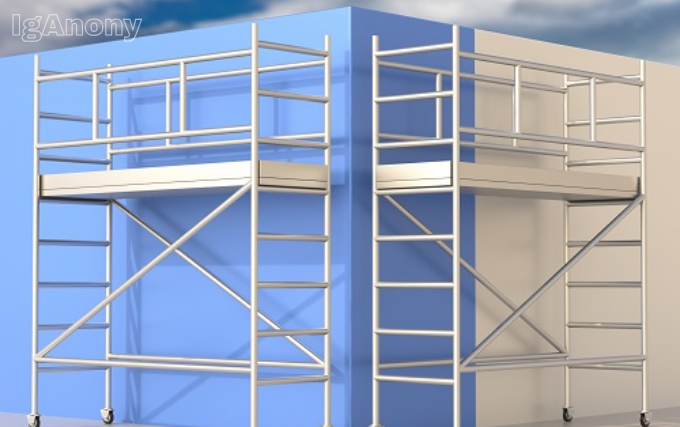In the contemporary construction and building maintenance industries, innovation in scaffolding has been a pivotal concern for enhancing safety, efficiency, and versatility on the job site. Among the various scaffolding systems available today, the mobile scaffold stands as a leading solution for projects that require adaptability and ease of movement.
Understanding Mobile Scaffold Systems
A mobile scaffold, by design, is a freestanding independent scaffold that incorporates wheels or casters at its base, allowing for seamless movement across a workspace. Crafted to be lightweight yet robust, mobile scaffolds are commonly manufactured from materials such as aluminium, ensuring they are both durable and easy to manoeuvre. This convenience significantly reduces setup and disassembly time compared to more traditional fixed scaffolding structures.
The incorporation of mobile scaffolds in various industry sectors can be seen in tasks ranging from interior and exterior building repairs to theatrical set construction. Their versatility is unmatched, catering to the ever-evolving needs of workers who require a stable platform that can be moved without disassembly.
Advantages of Mobile Scaffolding in Construction
When strategising for a project’s scaffolding needs, the benefits of a mobile scaffold system are manifold. First and foremost is safety. These systems are designed with guardrails and toe boards, which provide a secure working environment at varying heights. The rigidity and sturdiness of the structure reduce the risk of tipping, a crucial consideration in preventing workplace accidents.
Furthermore, the ease of mobility allows workers to cover a larger area without the need to dismantle and rebuild scaffolding. Therefore, projects that involve repetitive tasks over a large surface area, such as painting or plastering, see a boost in efficiency and a reduction in labour costs.
Another significant advantage is the capability of mobile scaffolds to support a convenient working platform. Workers have ample space to handle tools and materials, thus minimising the need to ascend and descend frequently. This convenience optimises workflow, reduces fatigue and contributes to overall project efficacy.
The Importance of Quality and Compliance
Selecting the right mobile scaffold solution is not merely a matter of convenience but also of legal compliance and assurance of quality. In the UK, for example, scaffold structures must adhere to stringent safety regulations stipulated by the Health and Safety Executive. These include specifications on weight load capacity, structure stability, and ensuring that installations are carried out by competent individuals.
Investing in high-quality mobile scaffolding from reputable suppliers ensures that you are providing a safe and legal platform for your workforce. It also guarantees that your scaffold will stand the test of time, delivering performance and reliability for numerous projects to come.
Choosing the Right Mobile Scaffold for Your Project
Determining the most suitable mobile scaffold for a project requires careful consideration of several factors. These include the height and weight requirements of the tasks at hand, the nature of the ground surface where the scaffold will be used, and the frequency of movement anticipated during the operation.
For indoor projects with flat flooring, such as in commercial buildings or retail spaces, a standard mobile scaffold might suffice. Conversely, outdoor construction work, which may involve uneven terrain, can demand more robust options with adjustable casters for stability.
Innovations in Mobile Scaffolding
The scaffolding industry continues to evolve with the introduction of new technologies and design improvements aimed at enhancing user experience and safety. Innovations in mobile scaffolding include lightweight composites for frames, more ergonomic designs facilitating quicker assembly, and advanced locking mechanisms for wheels to secure the scaffold when in use.
Further advancements also focus on modular designs, allowing for customisable configurations to suit unique project demands, and foldable options that simplify transportation and storage. The integration of smart safety features such as built-in level indicators and warning systems that signal overloading also exemplify the ongoing evolution in scaffold technology.
Training and Best Practices
In line with harnessing the benefits of mobile scaffolds, proper training for workers is indispensable. It ensures that the team is aware of best practices in erection, movement, and dismantling of the scaffolding. Adequate knowledge about the load capacities and the operation of locking mechanisms is crucial for maintaining a safe work environment.
Moreover, routine inspections and maintenance of the mobile scaffolding are essential to ensure its continued reliability and performance. Regular checks should focus on the structural integrity of the scaffold, the functionality of movement mechanisms, and the absence of any damage or wear that could compromise safety.
Conclusion
The introduction of a mobile scaffold system to your project can tremendously uplift productivity and safety standards. The practicality of a moveable, stable platform caters to a plethora of project needs while complying with safety regulations. As we continue to witness innovations in design and technology within the scaffolding domain, the importance of investing in versatile solutions such as mobile scaffolds remains ever crucial to the development of the construction and maintenance industries.
Overall, it’s clear that mobile scaffold innovations are playing a key role in elevating efficiency and safety standards across various sectors. By adapting to these dynamic solutions, projects can be elevated both literally and figuratively, ensuring that workers are supported to carry out their tasks in the safest and most effective manner possible.







